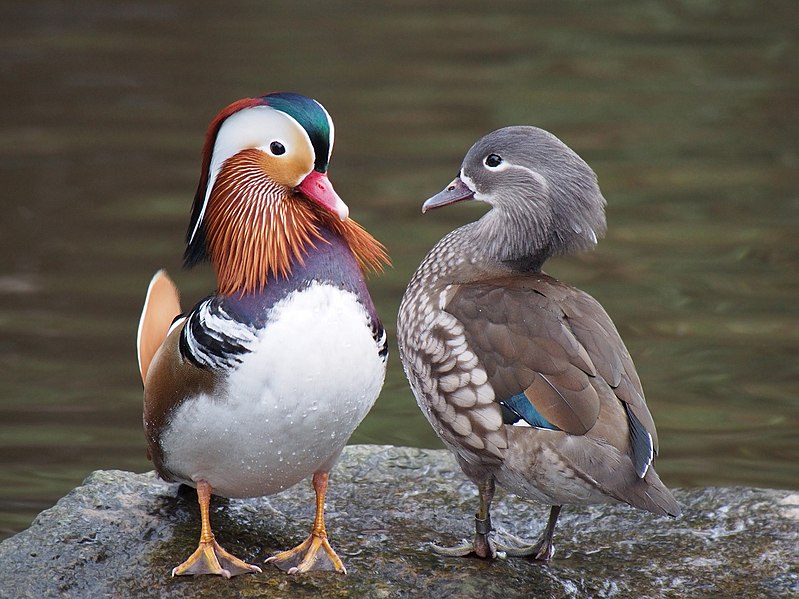Listen to Episode 63 on PodBean, Spotify, YouTube, or that other podcast player you like!
Sex adds a whole other level of complexity to the lives of organisms. On top of the struggle to survive fueling natural selection, they must also compete to find a mate and reproduce. In this episode, we discuss one of the more bizarre mechanisms driving evolution: Sexual Selection.
In the news
Giant extinct beaver appears to have avoided woody food.
Ancestral crocodylomorphs may have been warm-blooded.
A 50-million-year old school of fish grouped just like modern fish do.
A crocodyliform from Texas may have had an omnivorous diet.
Sexual Selection
Sexual selection is the selective pressure on an organism to reproduce successfully, in contrast to natural selection, which focuses on an organism’s survival. These two evolutionary mechanisms can work together but also against each other.
Darwin first described sexual selection in On the Origin of Species. He recognized two main types of sexual selection:
Intrasexual selection occurs when members of the same sex compete for access to mating rights, such as through competitive fights and displays.

Intersexual selection occurs when one sex controls mating rights for the opposite sex, usually involving elaborate displays by one sex trying to impress their potential mates.

These can lead to some truly bizarre behaviors
Sexual Dimorphism
One of the results of intense sexual selection is that males and females can often end up evolving different body types or behaviors. This is know as sexual dimorphism.

Sexual dimorphism is often strongly correlated with parental care. In species where one sex provides most of the care for eggs or babies, sexual dimorphism tends to be more extreme, with one more drab sex dedicated to caring for young, and the other sex highly decorated for attracting mates (most birds are like this). In species where both sexes care for the young together, they tend to have less extreme dimorphism, or hardly any at all (albatrosses are a good example).
But strict sexual selection is not the only cause for sexual dimorphism. In many animals, females are larger simply because they have to carry the eggs or babies. Other cases can arise for environmental reasons or to avoid cannibalism.
And it gets even more complicated! In some animals, males come in two forms: the classic big competitive males and “sneaky males” who resemble females to avoid competing with the other males. Sneaky males are famous in elephant seals and cuttlefish.
In Fossils
Recognizing sexual selection in the fossil record is easier for some organisms than others. Often, paleontologists look to modern examples for comparison.

Exaggerated features in the fossil record often bring sexual selection to mind, since such traits often evolve for display or competition – think moose antlers, peacock feathers, etc.
But fossils can be tricky. It can be difficult to tell if an exaggerated feature in an ancient species is sexually-related or if it evolved for another reason. Paleontologists generally look for a few traits that sexually-selected features tend to exhibit: their growth rate changes during ontogeny; the show positive allometric growth; they’re generally costly to maintain without a survival purpose; and they’re often sexually dimorphic.
None of these criteria are guaranteed to identify sexual selection in an organism but they are good sources of support. Using these techniques, sexually selected traits have been identified in certain extinct animals such as Protoceratops and some pterosaurs.
More Sexual Selection
Sexual selection
Biologists probe asymmetric warfare between earwigs
What do earwigs do with those pincers anyway?
Tricky cuttlefish put on gender-bending disguise
—
If you enjoyed this topic and want more like it, check out these related episodes:
- Episode 61 – Behavior in the Fossil Record
- Episode 140 – Horns and Antlers
- Episode 53 – The Baculum (Penis Bone)
We also invite you to follow us on Twitter, Facebook, or Instagram, buy merch at our Zazzle store, join our Discord server, or consider supporting us with a one-time PayPal donation or on Patreon to get bonus recordings and other goodies!
Please feel free to contact us with comments, questions, or topic suggestions, and to rate and review us on iTunes!
One thought on “Episode 63 – Sexual Selection”